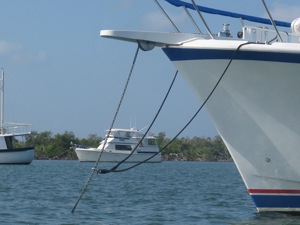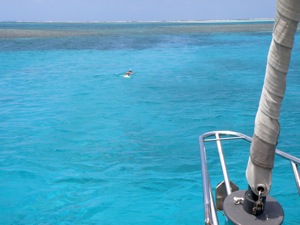If you’re using an all chain rode, think of a nylon snubber as insurance for your windlass! A windlass was not designed to be a cleat to hold anchor chain! In anchorages all around south Florida as well as the western Caribbean, we are continually amazed at how many boats utilize a snubber ineffectively – by not using it correctly, they don’t get any benefit from the “stretchability” of the nylon rode, which is the entire rationale for using it to begin with! We’re not experts by a LONG shot, but we were lucky enough to have an “old salt” show us how to use a snubber effectively early on in our cruising adventures.

FYI: SAIL Magazine published an edited version of my original “Insurance for your Windlass” article as a “Snub the Load” tips article in the January 2012 issue!
******************
If you’re using an all chain rode, think of a nylon snubber as insurance for your windlass! A windlass was not designed to be a cleat to hold anchor chain!
By using a snubber, you’ll prevent transferring the shock load from the chain to the boat and also lessen the potential for the anchor chain jerking directly on the anchor as it lifts off the bottom. Here are some tips for effective use of a snubber:
- Use a three strand nylon rode for maximum stretch – more stretch absorbs more motion.
- Use two separate lines attached to the chain hook, effectively making a bridle. Cleat one side off on each side of the bow. Using a bridle style double line snubber acts as insurance in case one side chafes.

Snubber on Winterlude — note the chain is slack and the two nylon lines are absorbing the load. -

Here the Snubber is slack and the chain appears to be carrying the load. The chain needs loosening so the snubber lines absorb the load. The correct length for each side of the snubber line will vary depending on your boat’s windage and the height of the bow off the water. The windier it is, the more snubber line you’ll need. We use a rule of thumb attaching to the chain about a foot under the water’s edge. Obviously, if it’s blowing, the snubber will be much longer because the chain will be stretched tauter than if there’s no wind and the chain’s hanging straight down. Using this rule of thumb, with our Passport 37 bow about 4-5 feet above the water, we need 3 feet from the cleat through the chock, another 5 feet to the water plus a foot … or an absolute minimum of 10 feet and when it’s windy the necessary length can easily be 20 feet on each side.
- Attach the rode to the chain any way you prefer, some prefer using a chain stopper (u shaped stainless plate), a rolling hitch or chain hook.
- When deploying the snubber, avoid the attachment falling off the chain by keeping tension on the attachment point as you let out more chain. Once it’s taut be sure to let out more chain. The chain should be sagging below the attachment point.
- The attachment stays attached to the chain when there’s no wind by the extra weight of the loop of sagging chain. If you don’t have sagging chain, then you really haven’t transferred the shock load to the snubber line. Let out more chain.
- If there’s the potential for chafe where the snubber line exits the boat, add chafe protection.

One final tip, when anchoring, hooking the snubber up prior to backing down lets the anchor rest for a brief period and also protects the windlass while you test to see if the anchor is going to hold.
Do you use your snubber differently? Leave a comment and let us know! Cheers! Jan














Snubbers are crucial to good anchoring in our opinion. Really paid off in hurricane winds! We use a rolling hitch and it’s never moved.
The weird thing is that you actually WANT the snubber to stretch — using too beefy a line defeats the purpose and puts too much stress on the anchor rode — you need a small diameter line. And three strand works best.
-Carolyn
Good article, snubbers are a must. On our Cabot 36 we also have a piece of commercial chaffing gear on the snubber that is large enough to slide on the 3 strand nylon. We adjust this to protect the line where it passes through the fairlead.
PS not trying to be picky but I believe you have a “chock” not a “chalk” on your bow. Cheers!
Thanks Deb! I never claim to be an expert, only an amateur learning more every day! THANKS for noticing the mispelling! I think it’s corrected now. 🙂
Very good article. I had never used a snubber on a monhull before when anchoring, just with a mooring. We now have an Admiral 38 catamaran which has a three strand nylon bridle (attached to each hull) that we attach to the anchor chain. It make anchoring a real pleasure with the all chain rode and definitely removes the shock loading that would otherwise be on the windlass. It also has the added benefit of greatly lowering the effective angle of pull on the rode.
how about a snubber when not using all chain? lets say I have 100 feet of chain only and I need 150 of rode out?
I’m assuming you put the 100 feet of chain down and then have it connected to 50 feet of nylon rode? The primary purpose of the snubber is for the stretch, which absorbs the shock when you’re using all chain. If you have 50′ of nylon rode between the chain & the boat, I would assume it would also stretch providing a similar advantage. Anyone with more experience? We’ve always used all chain. Would you use a snubber with a chain to nylon rode combination?
You still need to transfer the weight from the windless……I am assuming you can tie a knot (hitch or something)….
We are always in this situation as we only have 66′ of chain. Our snubber, a bridle in our case because we’re on a cat, is attached to the nylon rode with a rolling hitch. It works perfectly.
Ragtime uses 30 feet of chain and 250 feet of 3 strand nylon. In shallow water, I always let out at least 45 feet to be sure we have the needed stretch. If you have 66 feet of chain, like Mike does, and you are in water shallow enough that 6/1 scope is all chain, you need that 10 foot snubber line. When you use a rope/chain combination, in water deep enough that you have let out several feet of the rope, just be sure to tie it to a cleat to relieve the strain on your windlass.
All the post here are wonderful. Having also watched your video on mooring to mooring balls and witnessed to enormous range of motions and presumed loads, how reliable is the connection between the chain hook on the snubber and the anchor chain in a blow?
Many thanks,
Rachel.
Hi Rachel! A blow is when the connection between the chain hook & anchor chain is at it’s best because there’s significant tension between the two. The only times we’ve had trouble is when there’s no wind because there’s no tension between the snubber attachment point (chain hook/rolling hitch/whatever you choose to use) and the chain. And the big benefit is when the nylon rode takes the brunt by stretching. Hope this answered your question. Cheers! Jan
I’ve toiled over the idea of a hook coming undone during a no wind / rotating tides & current, whereby the load goes back onto the chain and the snubbers are left banging into the side of the boat. So, I found that they make a shackle type mechanism with a threaded locking pin and I think you can safety wire it too. You can get the snubber with line spliced onto it. I don’t have my notes handle, but surf around and you’ll see it. I think some of the old well experienced salts are starting to give them the thumbs up.
Kb
I really enjoy your site and articles.
My question: why do you leave the snubber under water?
I don’t understand the difference between it being under or out the water….
Many tks for all your information.
Bolinha
The snubber lines need to be long enough to absorb the impact of the waves — if you attached them above the water line they wouldn’t be very long. We actually lengthen ours depending on conditions. The more windy/wavey it is, the longer the snubber lines so there’s more opportunity for them to stretch – more nylon on the line = more stretch and wave action absorbed. Hope that answers your question! Cheers! Jan
Thanks for the information. You say that the line should be 3 strand nylon rode. What size nylon rode has enough strength, and yet the best elasticity? We will be using this as a snubber on a 49′ Jeanneau.
Sarah – it depends alot on where you’re sailing and what the anchoring conditions are — obviously more wave action & wind will require longer lines & stretchier nylon for a snubber. We used 5/8″ 3 strand nylon rode for our snubber and 5/16″ high test for our chain. Our boat is 37′ but 12 tons. Here’s a link for West Marine’s line guide for anchor chain/rode – scroll down & you’ll see a chart for size and weight of boat & rode recommendations. We always size everything up one size, so instead of getting ground tackle for a 37 foot boat, we upsize to a 41-45 footer. Lets us sleep better.
How do you use a snubber with the Kellit?
Hi Gregory! With some difficulty! David puts the snubber on first, nice & high – right up against the roller. Then the Kellet goes on the lower side of the snubber, run it down to where he wants it and cleats it off. Then he adjusts the snubber and releases the chain so the snubber takes over. Remember the chain should be slack so the nylon stretch snubber takes over. Enjoy! Cheers – Jan
A well written piece of information. We have owned our 1981 Albin 36 foot trawler for four years and only began using a 5/8″ nylon snubber/bridle as of last weekend. I do all my own boat maintenance and repairs, so splicing a snubber/bridle from three-strand 5/8″ nylon line and a stainless thimble, shackle, and grab hook was easy. Prior to the snubber/bridle, we only anchored using chain and the windlass absorbing all of the strain in a blow or moderate sea. We carry 150 feet of 5/16″ G4 chain, and no anchor line. I enjoy using the snubber/bridle now, and it works great! My question is, isn’t the stress and shock on the windlass unavoidable when you’re picking up the anchor in a strong wind and sea state? While a snubber/bridle serves to absorb the stress at anchor, those forces are unavoidable when picking up the anchor in any kind of sea state. I welcome your comments. Thanks, Mark
Hi Mark – we agree, sometimes stress on the anchor is unavoidable just as you describe. But the rest of the time, we like to give it a break. The strategy worked well for us. Cheers! Jan
Do you not get directly over your anchor before you start putting weight on your windless? We run the boat up over the anchor while pulling line or chain in with no tension on them, then when you get directly over the anchor, if there is rough seas the anchor will or should let loose and you can continue to reel it in. That way you should not have tension on the windless except for that fraction of a second.
hope this makes sense to all.
Bert
Two comments:
1) In addition to a nylon snubber for shock loads, what are the views on a chain “stopper” that is as strong as the chain if the snubber breaks or stretches longer than the chain slack. I’m thinking a high strength-low stretch line through the chain back to the (heavy duty) bow cleats may be a easy approach.
2) With respect to attaching the snubber to the anchor, the challenge is still to find a easy reliable way to attach that can be “reached” by hand. Even with short anchor rollers, it is still a challenge on many installations to reach the chain in-front of the roller with two hands.
I don’t like the idea of a bridle. That way the load is distributed between the two lines so you only get half the stretch that you’d get with a single line snubber.
To get a longer snubber (to get more stretch) you can attach the end of it to a midship cleat or even further aft. Clearly the snubber stretches over the whole of its length, not just the section between the bow and the chain.